The experience of the Agroforestry Workshop in the Zutiwa village showed how agroforestry can be a tool for the autonomy of communities by inspiring them to look even more closely at the richness of nature that surrounds them.
Authors: Ana Rosa, Rafael Lopes and Paulo Henrique Nenevê
Leia em português.
From September 14 to 16, 2023, the Zutiwa village, located in the Araribóia territory, Maranhão, hosted a Workshop on Agroforestry Systems. The event was organized by Zutiwa village leaders in partnership with the Meli Bees Network gUG and facilitated by experts from Rizosfera Consultoria Agroflorestal. The Zutiwa village, with approximately 1,200 residents, is the largest village in an indigenous territory located in the “arc of deforestation”, in a transition area between the Amazon and the Cerrado, surrounded by monoculture and threatened by forest fires, making the Araribóia territory an island of resistance and preservation of biodiversity.
Even with some entries affected by the forest fires, the event was attended by representatives from 9 villages in the Araribóia territory (Zutiwa, Crioly, Abraão, Buritirana II, Portugal, Formiga, Barreirinha, Vargem Limpa and Ipiranga), as well as members of 3 other indigenous communities (Terena, Krahô and Suruí Aikewara) and 6 non-indigenous communities (Frei Henri, Campo de Perizes, PDS Roseli Nunes, Nova Canaã, Deus te Ama and Dalcídio Jurandir). A total of 54 people from these 18 communities came together to learn more about agroforestry practices.
The technology shared during the workshop works towards production that combines commercial crop plantings with forest and service species, drawing inspiration from the diversity of nature. These plant combinations evolve over time and space in search of greater productivity, greater ecological resistance and, above all, with the aim of regenerating natural resources, especially those most vital to production, such as soil fertility and water.
This text will give an overview of how this was covered during the workshop.
Day one
The courtyard of a local school served as the starting point for the workshop meetings over the next few days. At the first meeting, the participants introduced themselves with mimes of their favorite animals, spontaneously sharing a little about their relationship with the local fauna. It was a light-hearted dynamic that created a cheerful and relaxed atmosphere that remained the basis of the whole event.
We then began a dynamic called a logical framework, the aim of which was to make the reality of the territory common, as well as to give everyone a perspective on the indigenous way of life in the past, how much this way of life has been altered in recent years as a result of the influence of non-indigenous people, who have purposely weakened all indigenous resistance, using welfare as a tool for this cultural and agricultural weakening. Based on this reality, we are evaluating the prospects for the future if we don’t take action, especially to recover our ancestry, and what actions need to be taken so that the indigenous way of life can be resumed and all resistance strengthened through these actions. “The future is ancestral” .
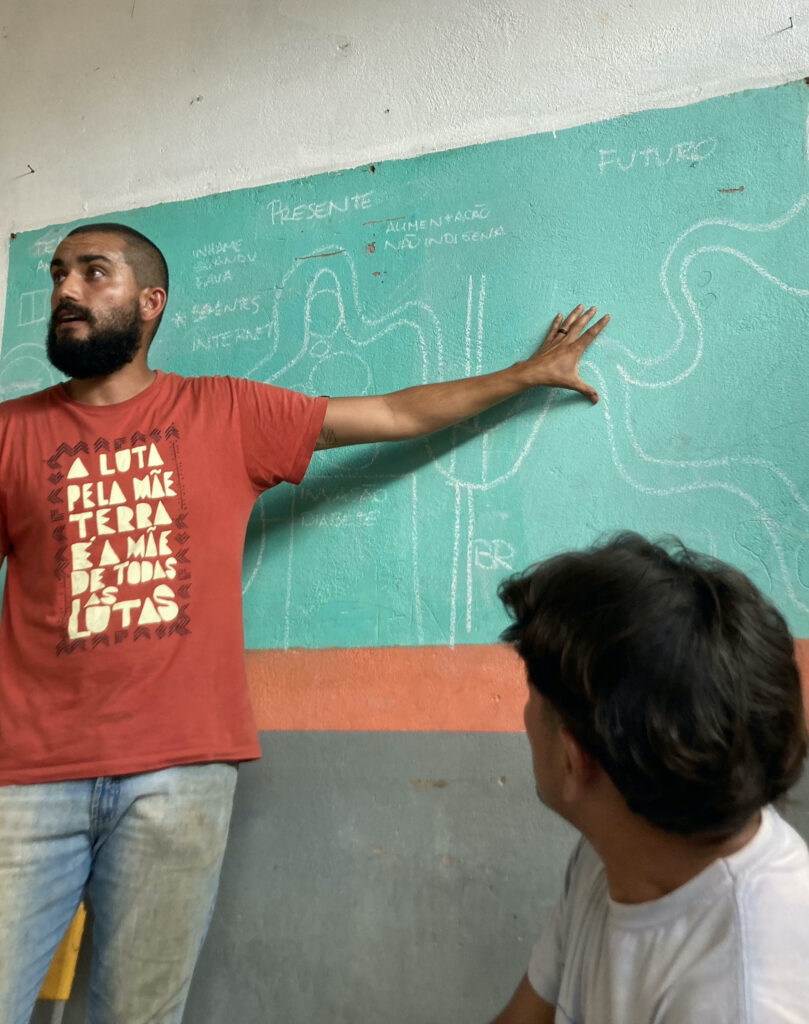
For this dynamic we used the Zutiwa River as a reference, represented graphically on the blackboard, and divided it into three parts: past, present and future. In the past, the key points were food sovereignty, high life expectancy and a preserved way of life. In the present we found non-indigenous food, with ultra-processed foods, as the main pillar of cultural weakening and related to health problems reported by participants from different indigenous communities, but which were non-existent in the past, such as diabetes and high blood pressure. In the midst of all this, they also described the evasion of territories as a result of cultural weakening, creating a major threat to the maintenance of the indigenous way of life.
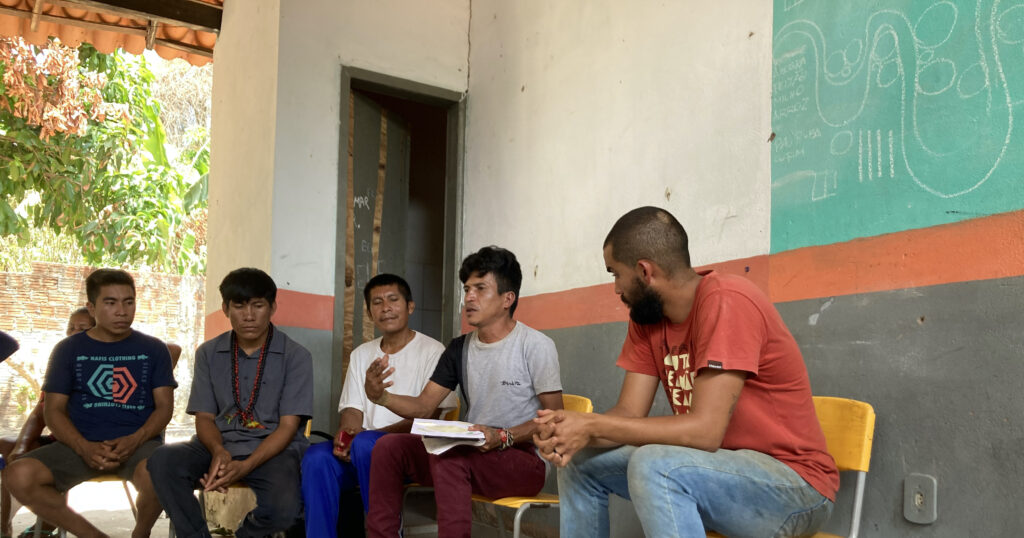
For the future, we have created a bifurcation in the river, bringing two possibilities for the future: one if we continue in this same process without any change, causing the situation reported in the present to worsen, and the other if we rescue indigenous culture through agriculture and food, strengthening indigenous resistance. On this decision, Vavá Terena, an indigenous educator and participant in the workshop, comments: “We are aware, based on ancestral wisdom, that healing today’s society and a healthy future will only be possible if we see the earth as part of us, as a mother, and the whole environment as our brothers and sisters, as well as our bodies and our spirits. Only in this way can we offer a healthy life for future generations.”
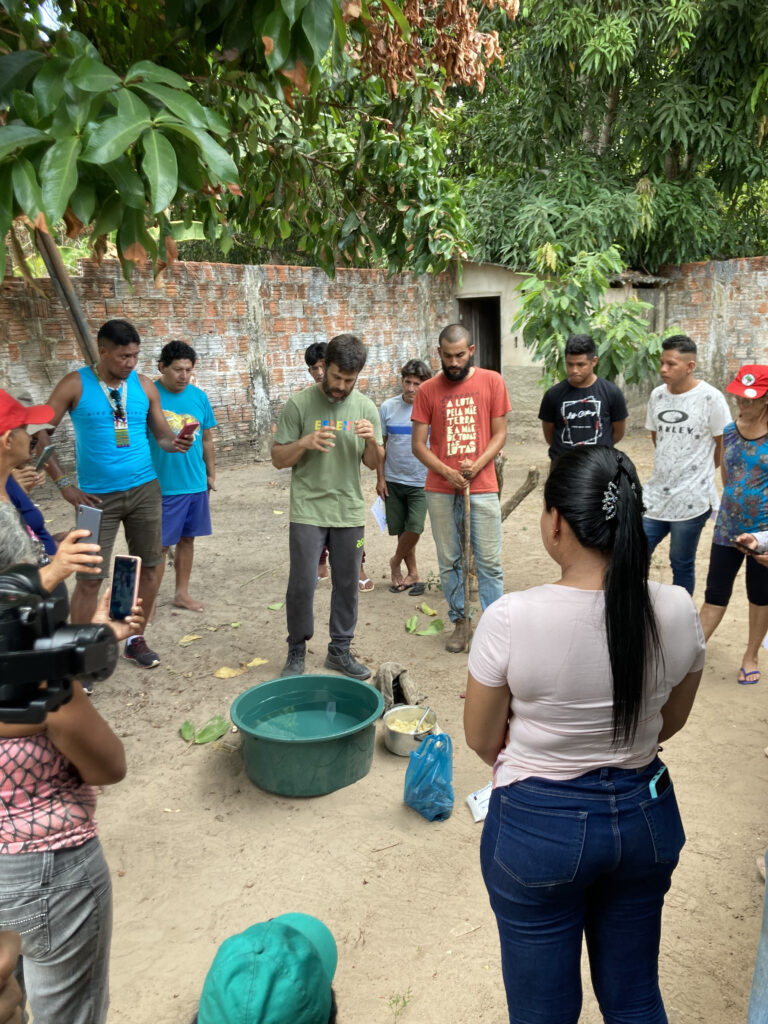
In addition to the agroforestry foundation shared during the workshop, another highly efficient and low-cost production technology was shared: the JADAM method of organic production. With recipes that strengthen the soil’s microbiota using materials that are easily accessible to the communities, this method aims to give back to farmers the tools for soil management, nutrition and pest and disease control, giving them more autonomy, resistance and productive efficiency. On the first day, we used this method to prepare a JMS (JADAM Microbial Solution), which was used during the workshop.
Day two
Organic material as an example of available wealth and its optimal use was the main theme of the second day’s activities. The use of fire and its impacts were discussed, in contrast to the possibilities of working without fire and all the benefits that follow. The fundamentals of pruning and renewal intervention in plots with secondary vegetation were also covered, giving new meaning to and demonstrating the beneficial potential of a traditionally predatory activity – the indiscriminate felling of trees, replaced by synchronization pruning and dense planting of forest species. In addition, the group saw the importance of the abundance of seeds, already present on the Araribóia indigenous land.
In the practical sequence, the participants were divided into three groups according to their interests: (1) Pruning and Organizing Organic Matter, (2) Soil Preparation and (3) Seed Harvesting.
– Pruning and organising organic matter:
The group coordinated by Paulo Henrique Nenevê met in the area previously selected by the Guajajara leadership for the establishment of the agroforestry system. There, the group was divided into teams that worked on organizing the available organic material, always favoring the most demanding rows of trees and crops, in order to facilitate decomposition and rapid recovery of the soil.
– Soil preparation:
Rafael Lopes led the group that worked on preparing the area chosen for implementing the agroforestry model. The participants removed the organic matter that was on top of the future tree line, and loosened the soil manually (hoe and mattock), taking care as much as possible not to revolve the soil layers, after which we made cradles every 1 meter (40x40x40cm cradles), anticipating the planting of the seedlings that we would select after structuring the arrangement. The proximity of the first two groups allowed for a lot of interaction between them.
– Seed Harvesting:
Ana Rosa brought together the group responsible for collecting seeds, which was guided by the participants themselves, mostly Guajajara women from the Arariboia territory. The group visited various backyards in the community and found great biodiversity, showing the great wealth that the Zutiwa village already has to spare. We also met Guajajara elders who were happy with the activity and proud of their backyards. Patrícia Guajajara, a teacher, resident of the Zutiwa village and participant in the workshop, told us “I was impressed that day. It was a very simple action, close to home, but it made us look around and see the richness of our nature.”
After the harvest, the group had a good chat while preparing the seeds for use. “When the action happens collectively, it becomes even easier,” said Patrícia. The conversations revolved around the experiences the participants had with each seed or plant, recalling the great richness of their backyards. Patrícia said, “This action comes from ourselves, from the community members themselves. It further strengthens the love we have for our nature. It’s about caring, preserving and protecting.”
Collecting seeds in the territory is extremely important for the development of the project, as the seeds collected are adapted to the soil and climate conditions of the territory. Collecting seeds also makes it possible to observe and understand how species relate, structure and develop, and this knowledge can be replicated in the cultivation areas, as well as providing autonomy for the village’s plantations.
– Returning to the group
When the groups returned, they found on the floor a large quantity of Creole seeds brought by the participants and seeds from the previous activity. The participants gathered around this beautiful arrangement and were invited to talk about the seeds and the plant stored in it.
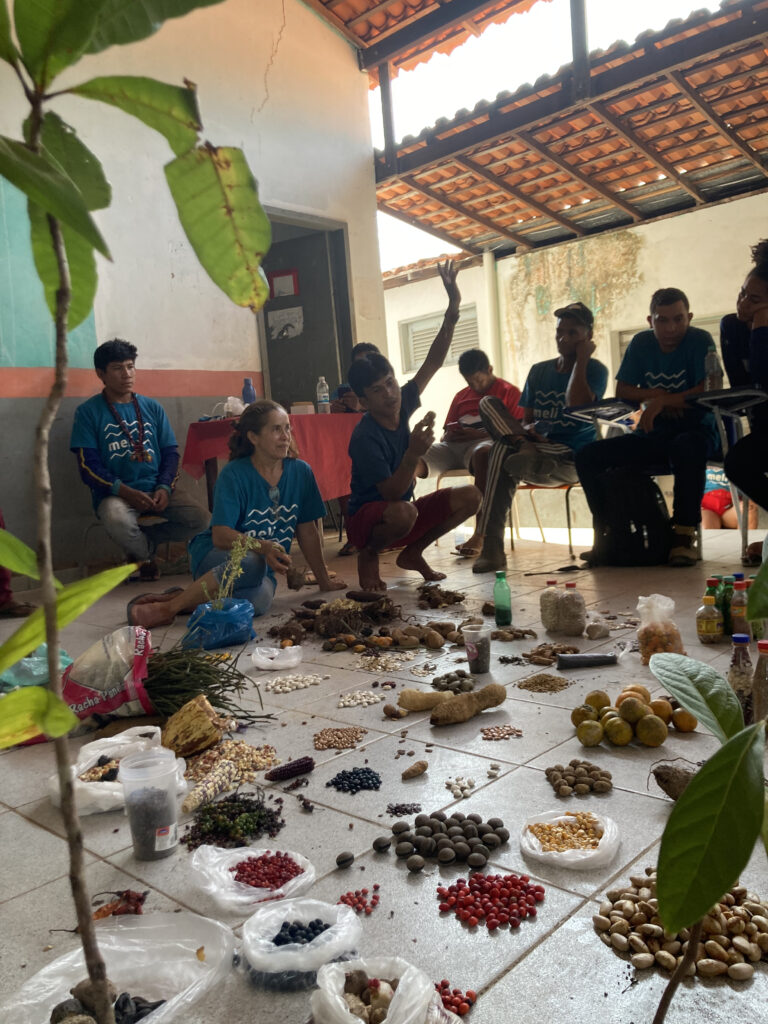
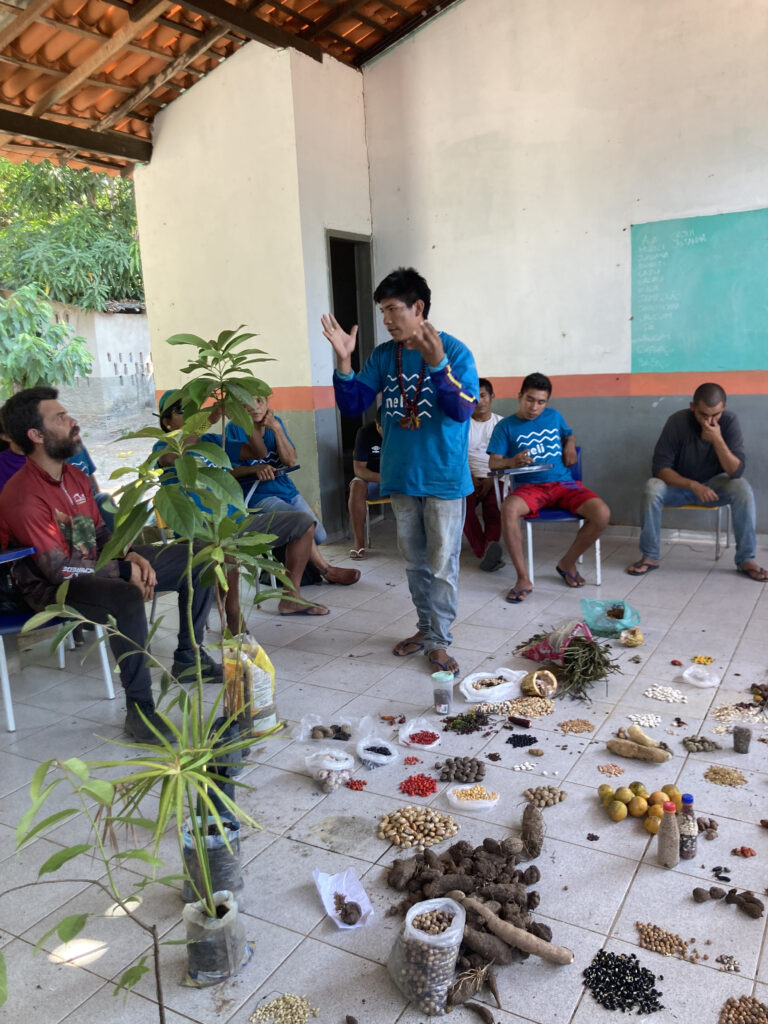
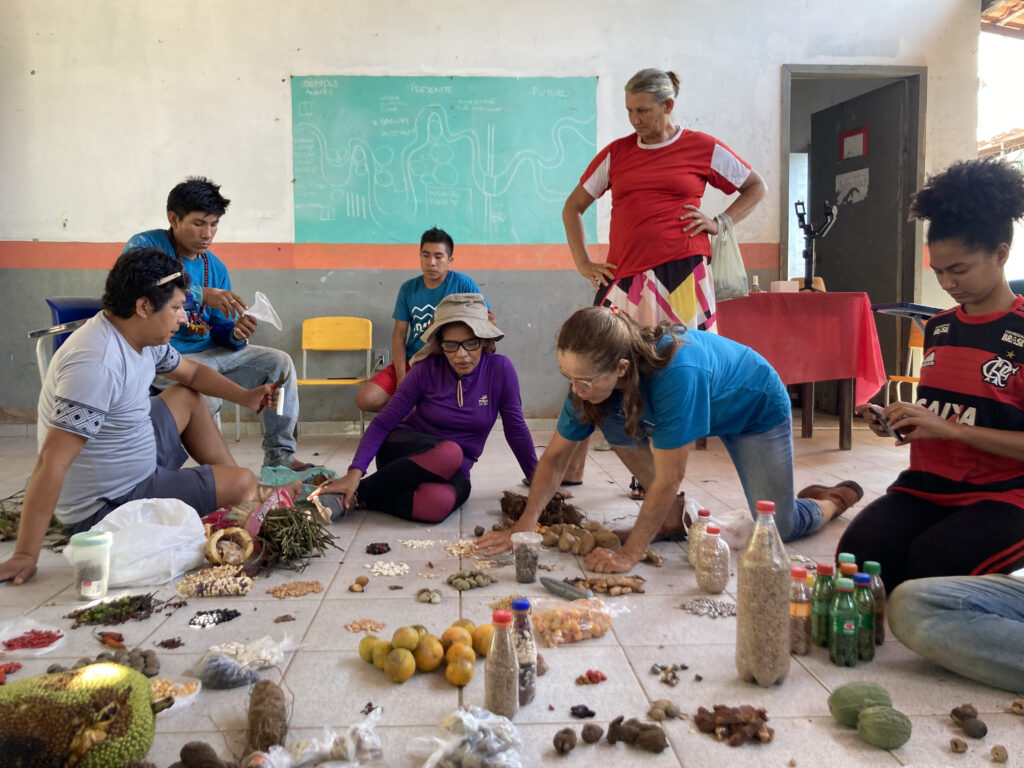
This moment was very powerful not only for facilitating the design of the agroforest inspired by the behavior of plants in the forest, but also for witnessing the richness of indigenous wisdom. The participants also shared how the fruit, seed or bark of the plant is used. There were a wide variety of uses, showing that biodiversity is also key to fighting various diseases, feeding the community and hunting game, traditional rituals and festivals, making bio-jewelry, and much more.
Based on the seeds available, an agroforestry arrangement was drawn up, using the demands and interests of the village as the basis for the design, as well as the recovery of practices and species used in the past. In this arrangement, more than 30 species were considered, including short-cycle crops such as guandu beans, pumpkin, cassava, papaya, bananas and long-cycle crops such as açaí, bacaba, buriti, cashew, cajá, andiroba, jackfruit and chestnuts. To structure this arrangement, we took into account the lifespan of each species, as well as each plant’s need for light, starting from an approach where, through an understanding of natural systems, we tried to submit the originality of the chosen species.
Within this design, we created lines of trees every three meters, positioning one tree per meter and between these short-cycle crops that play the role of creating these trees (pork beans, papaya, vinegar, guandu, okra and yams). Between the rows of trees, a traditional Guajajara garden was established, planting corn, fava beans, sesame and pumpkin. This type of arrangement makes it possible to plant trees of indigenous interest, as well as the farm crops that are the basis of indigenous food.
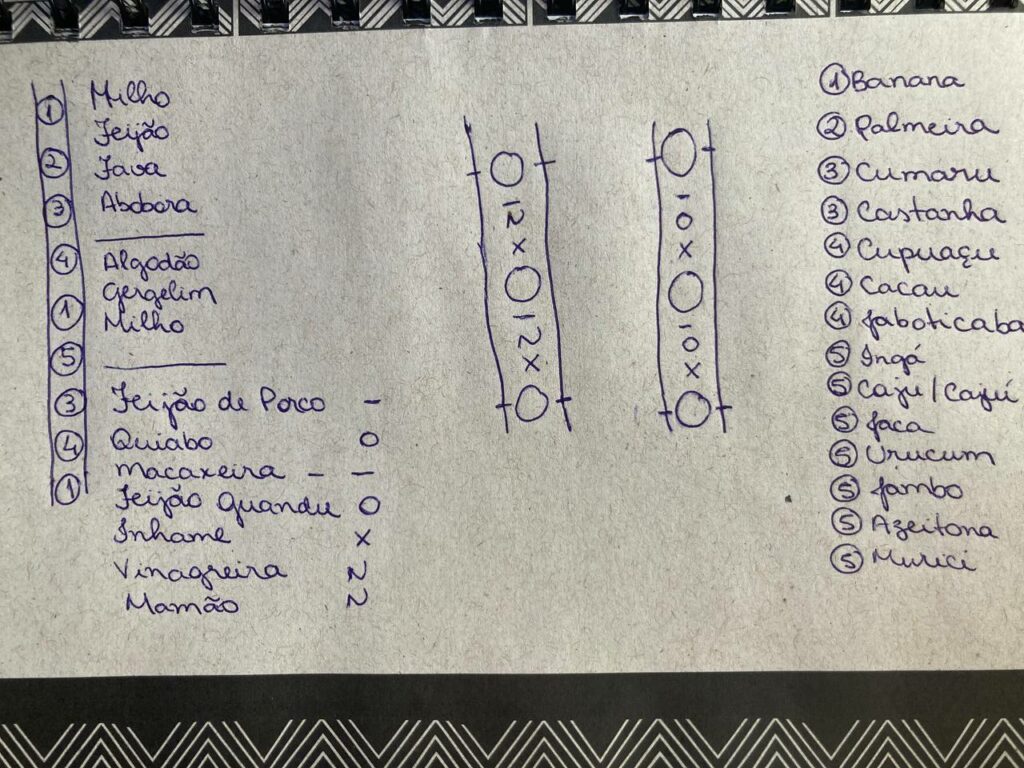
Third day and future planning
We started the third day in the land. We visited the home of Francisco Neto Guajajara, who has produced some seedlings with local seeds that were donated to make up the agroforestry. Francisco was one of the organizers of the event, but he couldn’t take an active part in the course as he is one of the brigade members leading the fight against forest fires in the Araribóia territory this year. He only appeared briefly on the last day of the workshop, overcome with emotion, when one of the fires had just been brought under control.
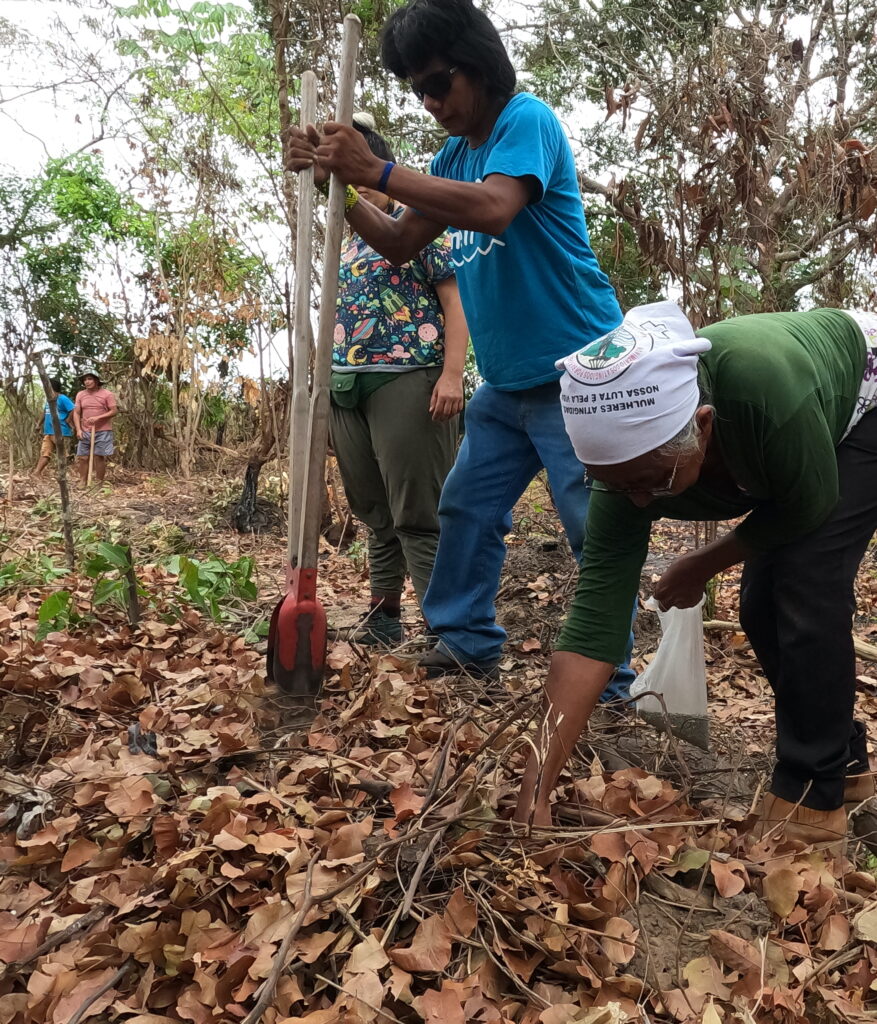
With the necessary seeds and seedlings, the planting in the model area was done. Each group was responsible for one activity. We started planting the larger species such as banana trees and native tree seedlings. After planting the seedlings, we covered the tree beds with the pruning material and leaves available on site, and after covering the beds, we started planting the tree seeds, short-cycle plants and manioc plants. The seeds of the short-cycle crops planted in the trees play a strategic role in the planting, as their speed of planting and lifespan create the trees of the future. Next, we planted the traditional Guajajara swidden between the rows, valuing the agricultural cultural revival.
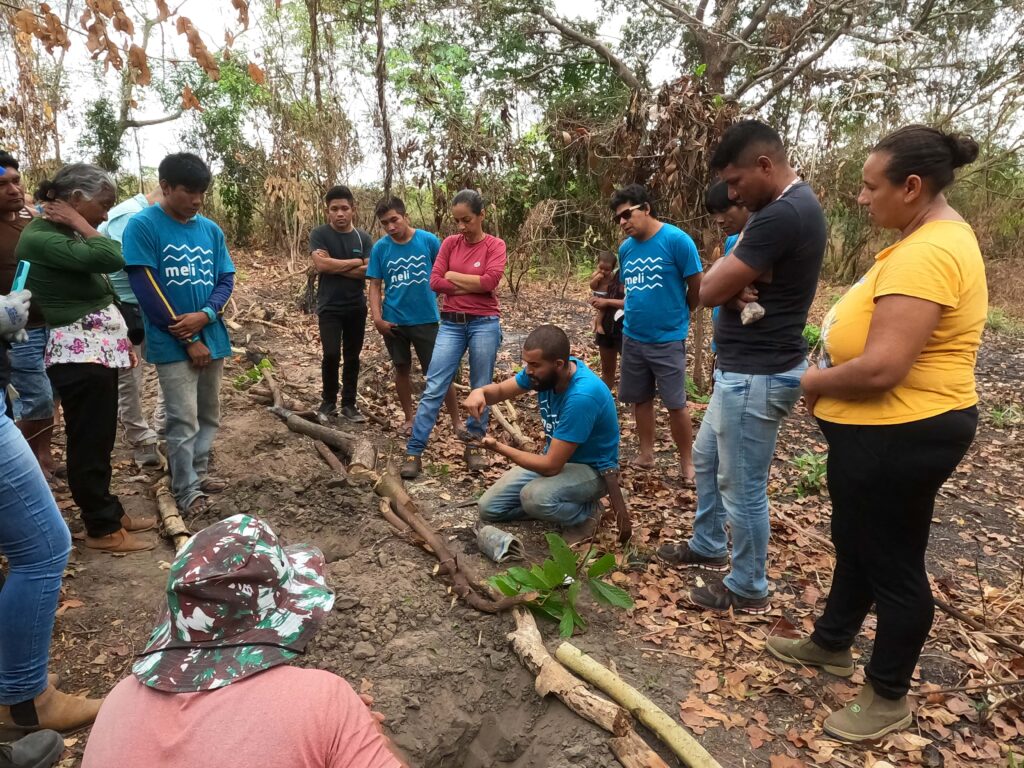
Continuing to share elements of the JADAM method, the third day introduced the concept of complementary plant nutrition in the method through JADAM Liquid Fertilizer (JLF). This is a simple, low-cost tool that involves various types of waste and fermentation in water in the presence of forest microorganisms. In addition to presenting the concepts, a type of JLF was prepared, in this case one rich in Potassium, Calcium, Phosphorus and minerals made from wood stove ash, with the addition of water, crushed grass and bait from microorganisms collected in the forest, for later application in the newly planted area.
The third day was also marked by planning future activities. To this end, we began by meeting a group of Guajajara participants to hear their demands, suggestions and plans for the continuation of agroforestry activities in the Araribóia territory. Here are the main points of that conversation:
- Integrating the school into the continuity of activities,
- Acquiring materials to support the agroforestry (fences, electrical installation, water pump, water tank, well, etc.),
- Maintain communication with Meli and the workshop facilitators,
- Set up a group of agroforestry caretakers in the Zutiwa village, with a list and roster, sharing responsibility for care,
- Develop more workshops in the territory, both initial workshops in other communities such as Abraão village, where several very active participants have come from, and management workshops in Zutiwa village, to maintain the agroforestry methodology in the area that was started,
- Offer logistical support for participants from other regions within the indigenous land,
- Set up a group of “agroforestry multipliers” within the Araribóia territory, connecting different regions,
- Record information about the seeds, as was done previously during the event, keeping the autonomy of information with the communities,
- Establishing a meliponarium together with the agroforestry.
After the conversation between the Guajajara group, we got together with the rest of the workshop participants to hear their perspectives on continuing the activities. The main points raised were:
- Develop meetings closer to each community present,
- Continuing the activities started in this workshop,
- Establishing a network of Creole seeds to strengthen the sovereignty of communities by developing agroforestry (living seed bank),
- Support the registration of entities created by the communities,
- Encourage more training,
- Registering information about seeds (mentioned again),
- Establishing a group of “Guardians of Good Food”, which could be strengthened by registering the information on seeds mentioned above,
Establishing a group focused on organizing events.
The event ended with several emotional reports from the participants. Tears showed their gratitude for such a generous welcome. Vavá Terena had a moving speech about the Guajajara reception, even in the face of so many challenges. Ana Beatriz, a Forestry Engineering student at the Federal Rural University of Amazonia and Meli’s intern, shared how this moment had an impact on her education. Thiago Guajajara, vice-chief of Zutiwa village, spoke about the importance of the activity for the village. Clearly the workshop left an important seed both in the Zutiwa village and in other participants.
As a souvenir of the workshop, the participants received a calendar designed by Francisco Neto Guajajara, who, as well as being a firefighter, is also a meliponiculturist and a great observer of nature. At one of our community meetings, he told us that he had made a calendar listing the main flowers visited by his bees each month of the year. We were all delighted with this achievement and thought of ways to maximize it even more. To this end, we connected Francisco with other people who could help in this mission, according to their own decisions. Heloísa Maeoka, a biologist and artist, illustrated some of the species mentioned by Francisco, and Yasmin Fernandes, a designer, put together this beautiful calendar:
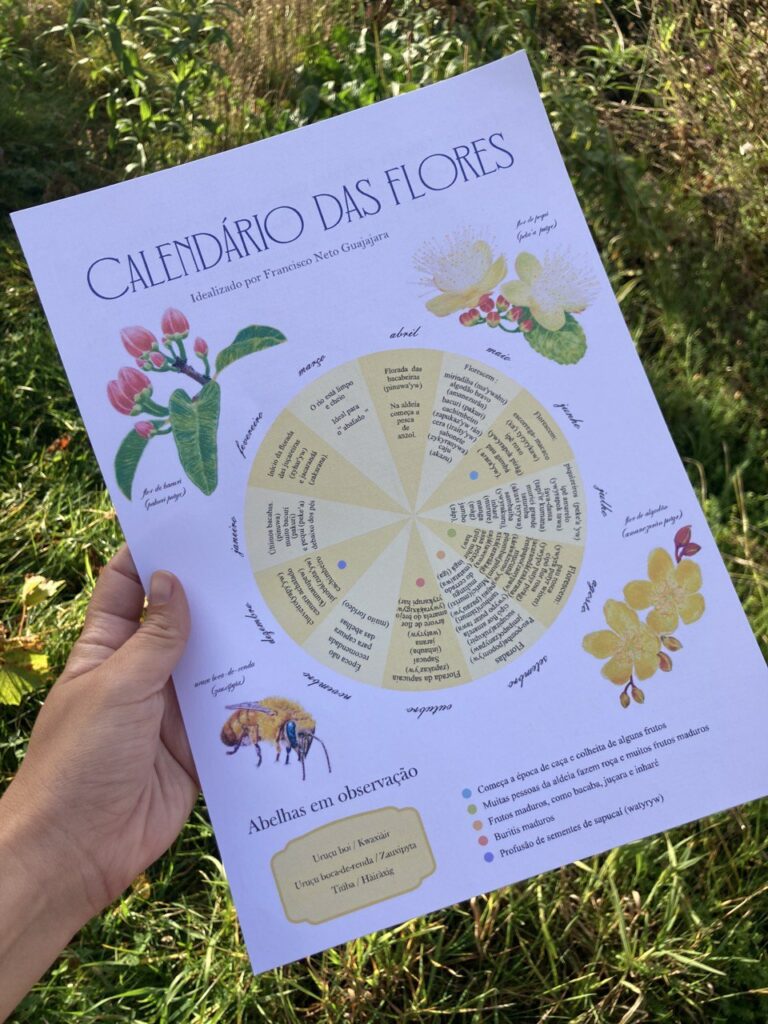
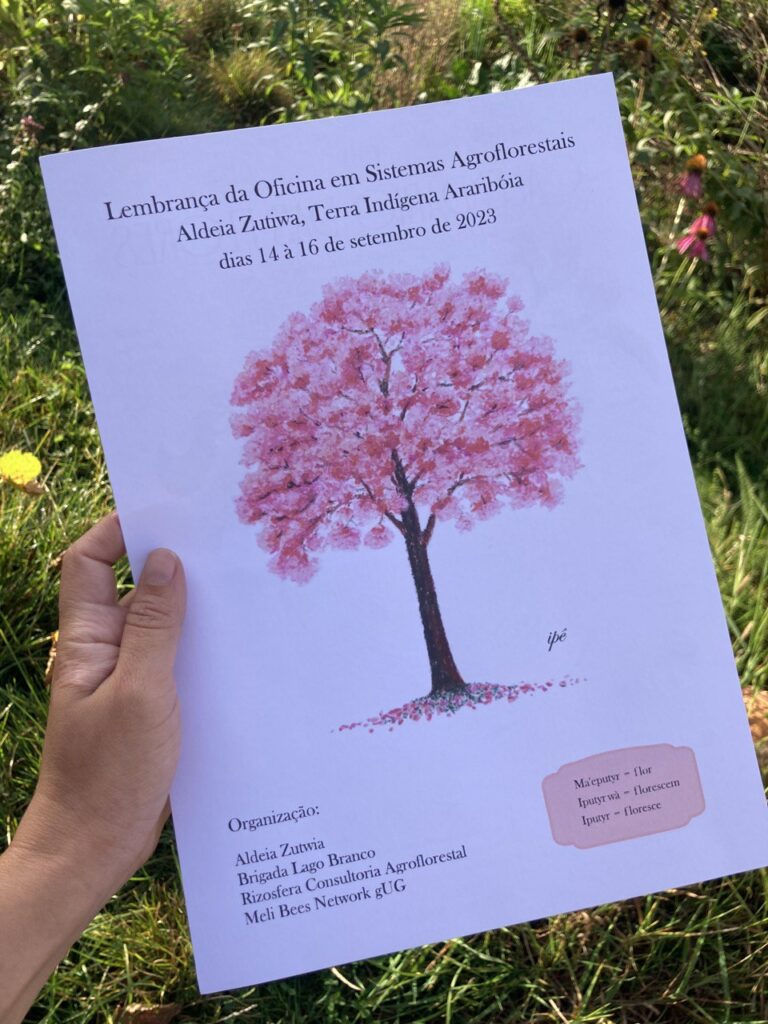
Multiplication
The greatest proof that the seed planted during the workshop has found fertile soil is seeing the seed grow and the positive impacts multiply. To provide a good environment for this multiplication, Meli works on building an impact network where community leaders can strengthen each other in a space where they build relationships of trust. As a way of keeping in touch after the workshop, participants were invited to join the Meli Network’s general WhatsApp group. Guajajara, Suruí, Terena and Frei Henri community groups were some of the workshop participants who shared photos and videos related to the different techniques they learned during the workshop and put into practice in their communities.
Just a day after his return, Arukapé Suruí has already shared a video of activities he carried out with other residents of his village, putting into practice techniques he learned during the workshop. He worked on banana plantation management and pruning to prevent the banana moth (Cosmopolites sordidus), one of the main banana diseases. This technique, along with the JMS (JADAM Microbial Solution) method, was shared in a workshop that took place in the Frei Henri community, where Reni and Francisca, two participants in the event who are part of the community, led it together with Ana Beatriz.
The JMS method was especially popular in the communities, which shared the great results very quickly. Vavá Terena said he had already used the recipe in his area and had already felt more strength in renewing the leaves of his orange trees. He also said that the recording he made during the workshop was very useful for remembering all the details of the recipe. Elizabete, a participant from the Nova Canaã settlement who has also replicated the recipe, said that “the plants showed new life, they became more lush”. Marta Maria, who only took part in the multiplication workshop held at Frei Henri, also noticed the difference in her planting, such as the development of her melon and cabbage.
This workshop was a milestone for our organization and the experience will help us lay the foundations for Teia da Terra. An Impact Network to strengthen agroforestry systems through community leaders who act as multipliers.
Feel the regenerative energy!
This short video can bring you closer to what was this powerful workshop:
Your donation can have a positive impact on the world!
Subscribe to receive our Newsletter!
Find us also at Linkedin, Facebook, Twitter or Instagram
www.meli-bees.org
❤️

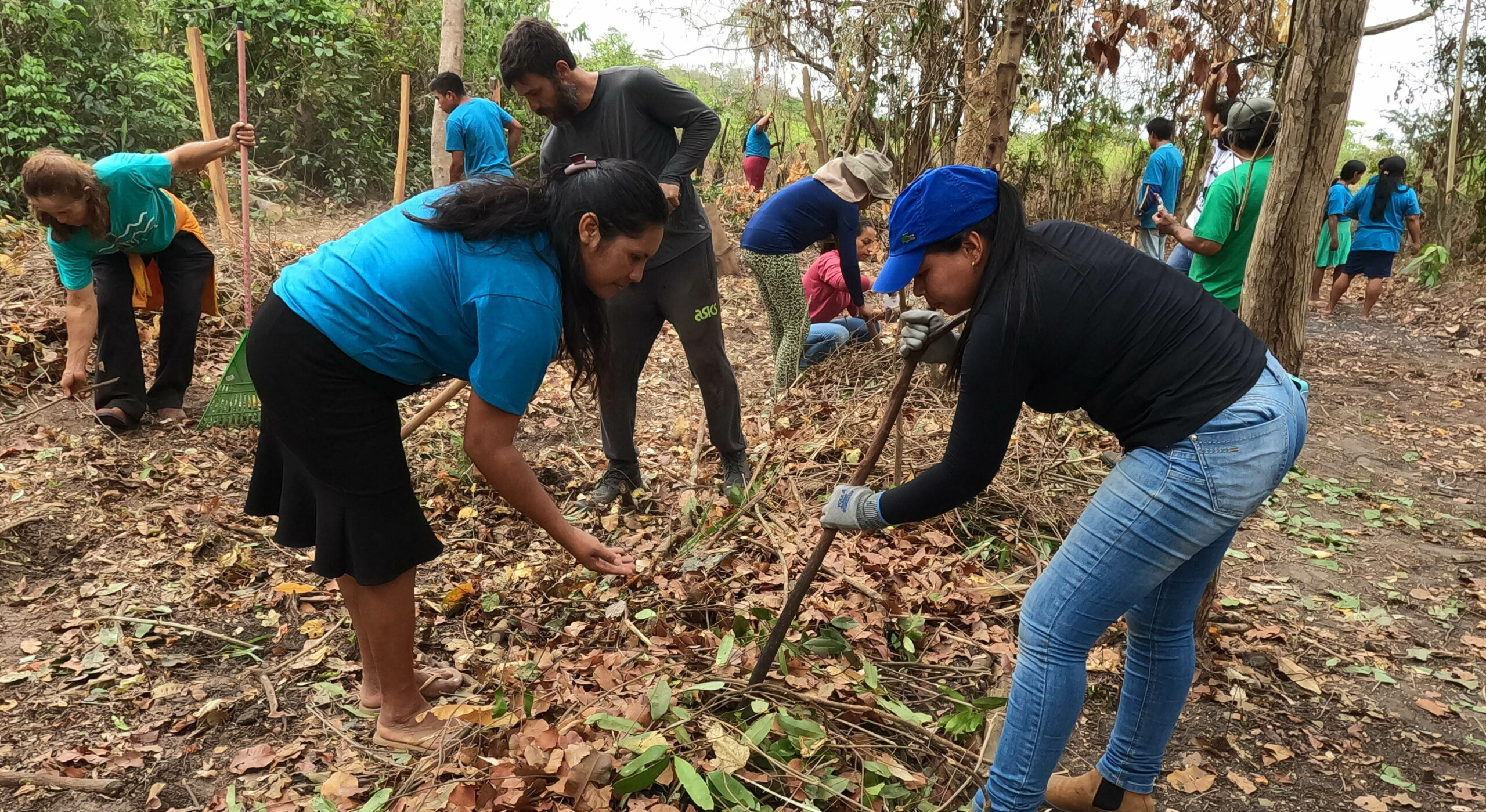
One Reply to “Agroforestry workshop in Zutiwa village ”